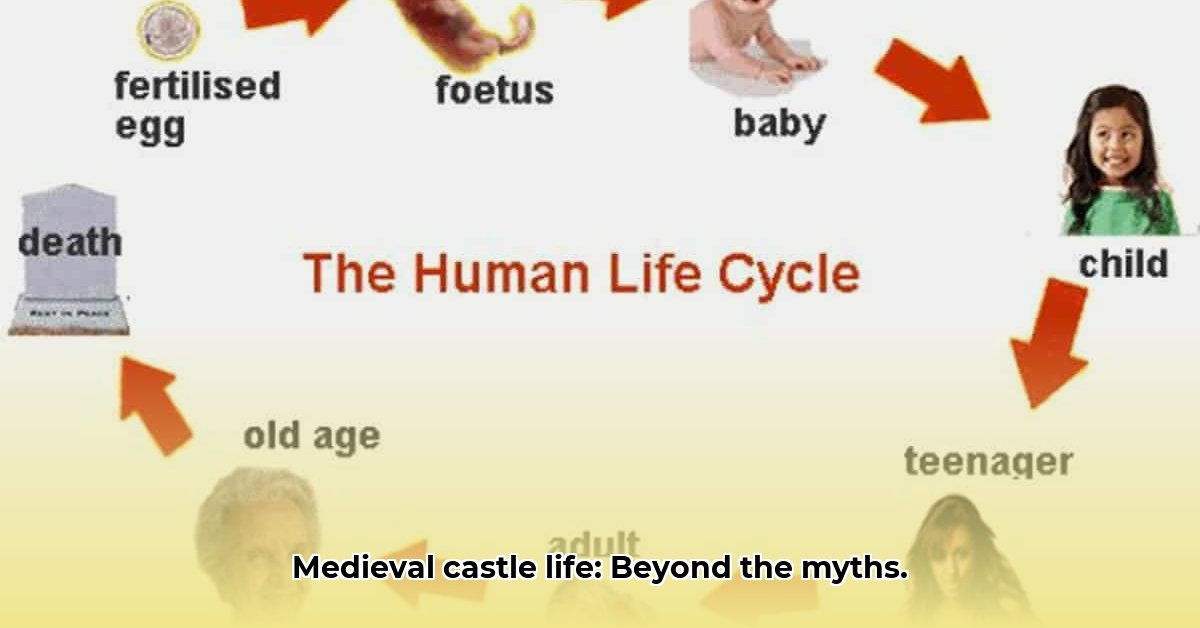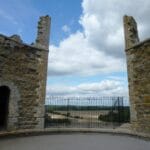Ever wonder what it was really like to live in a medieval castle? Forget the fairy tales of knights and endless feasts. This article digs into the everyday lives of people in medieval castles – from the lords and ladies to the cooks and stable hands. We’ll explore how the castle worked as a small society, its economy, its defenses, and even its surprisingly complex sanitation challenges. Get ready for a detailed and insightful look at a world far more interesting and complicated than you might think! To understand the societal structures better, learn more about medieval education.
Medieval Castle Life: Unveiling Daily Routines
Forget the romanticized images of glittering banquets and epic sieges. Life in a medieval castle was a much more complex and surprisingly ordinary affair, a vibrant tapestry woven from the daily lives of a diverse community. Think of it as a small, walled town, bustling with activity, where everyone, from the lord to the lowly stable hand, played a vital, albeit very different, role. What role did defense play in shaping daily life within the thick stone walls? How did hygiene challenges impact everyone within the castle walls?
Hierarchy and Daily Life Inside
Imagine waking up in a medieval castle. Your experience would depend entirely on your place in the strict social order. At the top sat the lord and lady, their family, and a small circle of trusted advisors. These folks lived in relative luxury, enjoying spacious rooms, finer food, and more comfortable bedding – though even they had their share of inconveniences, like the lack of running water or effective heating during the harsh winters. Their days were filled with managing their estates, overseeing construction projects, settling disputes among their people, and attending religious services in the castle’s chapel. They also engaged in political negotiations and maintained alliances with other nobles.
Below the ruling family were the knights, highly trained warriors bound by oaths of loyalty to the lord. Their lives were primarily dedicated to maintaining the castle’s defenses, practicing their fighting skills (swordplay, archery, horsemanship), and participating in tournaments – a mix of training and high-stakes competition. Knights assisted in administering justice, collecting taxes, and ensuring the lord’s decrees were enforced.
Further down the social ladder lived the servants – a huge group encompassing cooks, maids, stable hands, blacksmiths, carpenters, and countless others. Their days were filled with hard labor, ensuring the smooth running of the castle. Imagine the cooks preparing meals for dozens (sometimes hundreds!), or the maids scrubbing floors by hand with rudimentary cleaning supplies. The stable hands cared for the horses, essential for transportation and warfare. Blacksmiths crafted and repaired tools and weapons. Their living conditions were far more basic than those of the nobility, likely cramped and shared with other servants. Even laborers lived within the castle walls, contributing to the constant upkeep of the imposing structure. Despite their different roles, every single person, from the most powerful to the humblest, was a vital cog in the castle’s social machinery. Even children contributed, working as pages or assisting with household tasks.
Fortifications and Constant Vigilance
The castle itself was a marvel of medieval engineering, built primarily as a fortress. Forget pretty pictures; these were serious defensive structures! Thick stone walls, towering corner keeps, strategically placed arrow slits (also known as loopholes), and deep moats were designed to keep out invaders. Gatehouses, often equipped with drawbridges and portcullises, controlled access to the castle. Life inside was profoundly influenced by this constant awareness of potential attacks. The layout of rooms, the location of guard posts, and the need for constant vigilance were all part of daily life. For the castle inhabitants, defense wasn’t just a matter of battles; it was an ever-present reality that shaped how they lived, with regular drills and a practiced response to alarms. Watchtowers provided elevated vantage points for spotting approaching enemies. The castle’s water supply was carefully protected to withstand sieges. The arrival of gunpowder weaponry eventually changed all this, making many of the old castle defenses obsolete over time and changing the nature of warfare beyond the walls, prompting the development of new defensive strategies and architectural adaptations.
Castle Economy and Cultural Characteristics
The castle wasn’t an isolated island; it was a vibrant economic hub. Its very presence attracted skilled craftsmen, merchants, and traders, creating a bustling local economy. Markets were often held just outside the castle walls, facilitating trade between the castle inhabitants and the surrounding communities. The castle generated jobs and boosted regional trade. The castle chapel, often the central building beyond the lord’s quarters, served not only as a place of worship but also sometimes as a school for the children of the nobility. Religious festivals and ceremonies were important social events. Entertainment wasn’t limited to the upper classes; while the nobles enjoyed grand feasts and tournaments, the servants likely found their own ways to pass the time, possibly with games, storytelling, or simple socializing. Music and dance were popular forms of entertainment. We know relatively little about the daily lives of the lower classes, however, as records focusing on their experiences are scarce. Ongoing research aims to uncover more of this untold history. Did castles inadvertently foster cultural exchange through these economic interactions? The exchange of goods and ideas contributed to a dynamic environment within and around the castle.
Domestic Life in the Middle Ages
Step inside the castle walls, and you’ll find that life wasn’t all about grand halls and formal dinners. Beyond the Great Hall, the scene of lavish banquets and important meetings, lay a world of smaller, more private spaces. The lord and lady likely had private chambers (solars), offering a small degree of seclusion. But even for the nobility, life was far from luxurious by modern standards. Kitchens were bustling, often smoky and hot places, with open fires and rudimentary ventilation. Stables were the domain of horses and the smell of hay. Workshops echoed with the sounds of hammering, sawing, and the clang of metal on metal. Bakeries produced bread, a staple food. Breweries produced ale and beer, common beverages.
Hygiene was a major problem; sanitation was primitive at best, and disease was a constant threat. Garderobes (latrines) were basic and often unpleasant. Bathing was infrequent. The very design of the castle – its layout, the materials used in construction, and even the placement of windows – reflects the challenges and values of medieval life. Researchers are still deciphering the clues hidden in the architecture to better understand what daily life was like for everyone living within those walls. What domestic adaptations evolved to mitigate the harsh realities of castle life? The use of herbs and spices to mask odors was common.
Power, Feudal System and Governance
The feudal system was the backbone of medieval society and heavily influenced life within the castle walls. The lord and lady weren’t just wealthy landowners; they were also judges, administrators, and protectors of their people. Their authority and influence extended far beyond the castle walls. Knights, trained warriors, played a critical role in defending the castle and upholding the lord’s power. This relationship between the lord and his knights was based on mutual obligation: protection and loyalty were exchanged for land and status.
Even the castle ladies, despite their limited roles under the strict social rules of their time, could wield considerable influence. They often managed the day-to-day running of the estate, mediated disputes, and in some cases, even played a military role, especially during sieges when the lord was away. While the extent of their power varied, they played an important part in the castle community. They oversaw the household staff, managed supplies, and provided medical care.
A Snapshot of Medieval Castle Life
| Aspect | Key Characteristics | Potential Challenges |
|---|---|---|
| Social Structure | Strict hierarchy; power concentrated at the top; interdependent roles | Inequality; limited social mobility; potential for conflict |
| Daily Routines | Varied greatly depending on social standing; mix of work and leisure | Long working hours; harsh living conditions; disease risk |
| Defense & Warfare | Castles were strategically designed fortresses; constant vigilance required | Vulnerability to sieges; technological advancements changed warfare |
| Economy & Culture | Castles stimulated local economies; religious and social activities central | Dependence on surrounding regions; economic instability |
| Domestic Life | Living conditions varied greatly; sanitation was a significant challenge | Disease; fire hazards; cramped quarters; lack of privacy |
| Governance | Lords and ladies were administrators and judges; the feudal system shaped social relations | Maintaining order; conflicts between different social groups |
This table offers a quick overview of the many facets of life in a medieval castle. It’s a world more complex, more human, and far more interesting than you might initially think. Ongoing research continually adds to our understanding, revealing new details and refining our insights. There’s still much to discover about this fascinating and often overlooked period in history.
Impact of Medieval Castle Sanitation Practices
Key Insights:
- Medieval castle sanitation, though rudimentary, significantly impacted daily life.
- Garderobes and chamber pots were common, leading to odor and hygiene challenges.
- Waste disposal variations affected disease spread and impacted the environment.
Managing Waste in the Middle Ages
Imagine life in a medieval castle. What comes to mind? Jousting tournaments? Lavish feasts? While those images have some basis, how did medieval castle sanitation practices impact daily life in a far more profound way? The reality was far less glamorous, particularly concerning waste disposal. The primary toilet facility was the garderobe – essentially, a chute leading to a cesspit or, often, directly into the moat. Chamber pots were also ubiquitous. The smell, you can imagine, would have been… potent. This constant presence of waste didn’t just impact the senses; it significantly influenced the spread of disease and overall health. The lack of soap and proper cleaning supplies further exacerbated the problem.
Hygiene Concerns and Social Divide
Did everyone experience this lack of sanitation equally? Absolutely not. While the basic facilities were similar across social classes, the realities differed. The nobility may have had slightly more privacy and perhaps more frequent access to clean water (though this is much debated among historians). They might have had servants to empty chamber pots and clean garderobes more frequently. But for the vast majority of castle inhabitants, the daily struggle with hygiene and waste disposal was a shared reality. This unequal distribution of resources and access to relative cleanliness further exacerbated existing social disparities, impacting health outcomes disproportionately. The lower classes often had to rely on communal facilities and lacked the means to maintain personal hygiene effectively.
Impacts of Disease and Daily Life
The lack of proper sanitation had a brutal impact. Infectious diseases were rampant, and their spread within the castle walls was largely determined by these inadequate waste disposal systems. Think of typhoid, dysentery, and cholera. The close proximity of people and waste created a breeding ground for these deadly diseases. Indeed, how did medieval castle sanitation practices impact daily life is best understood through the lens of disease prevalence and death rates. Outbreaks of disease could decimate the castle population, impacting daily life and routines.
Designing for Defense and Function
The architectural design of castles often reflected the need to manage waste, albeit primitively. The placement of latrines, often projecting from outer walls, was a strategic decision, although more out of convenience than sanitation. This minimized the spread of odors and potential contamination of living spaces, at least to some extent. This is a fascinating example of practical concerns being integrated into the overall design. It’s important to note these “solutions,” while practical within the contexts of medieval knowledge, are woefully insufficient by today’s standards.
Changes in Sanitation Over Time
Over the centuries, there were some subtle improvements in castle sanitation. More elaborate latrine systems were developed — and even communal latrines appeared — to manage waste more effectively, and, critically, to minimize the spread of disease, at least slightly. Some castles even had rudimentary drainage systems. Royal castles, with their royal inhabitants, were often at the forefront of sanitation improvements. But these developments were gradual. The fundamental challenges of limited resources, technology, and understanding of hygiene remained substantial hurdles throughout the medieval period. The lack of proper sewage systems continued to pose a significant health risk.
The Intricacies of Medieval Castle Architecture
Key Points:
- Daily routines were incredibly diverse.
- Medieval Castle Architecture significantly impacted daily life.
- Domestic Life Innovations, gradually transformed the castle environment.
Daily Realities: From Lord to Servant
Imagine waking in a drafty stone room – the reality for many castle inhabitants, even the privileged. For the lord and lady, the day began with religious observances and managing the castle’s affairs. This included overseeing household accounts, meeting with advisors, and making decisions affecting the estate. The bailiff will collect taxes from the locals, and the lord will determine justice in the great hall. Their lives were a blend of privilege and weighty responsibility. Meanwhile, the servants were already bustling – cleaning, preparing meals, and tending to the needs of the castle’s residents. Chamberlains managed the lord’s private affairs, while stewards oversaw the overall management of the household.
The castle kitchens were bustling hives of activity. Cooks prepared meals using seasonal ingredients. The scullery maids ensure that the kitchen is clean. The great hall, the heart of the castle, served as a dining area and gathering place for residents and guests during meals. These were social events as much as sustenance.
For the lower classes, the work was grueling. Maintaining the castle, cleaning, and farming required immense physical labor. Conditions were often cramped, cold, and unsanitary. The lack of windows and proper ventilation contributed to poor air quality.
Impacts of Medieval Castle Architecture
Early castles, simple motte-and-bailey structures, offered basic protection but little comfort. Life inside was stark. The development of stone castles significantly improved living conditions. Larger windows offered more light, while fireplaces provided warmth unavailable in earlier constructions. These changes, however small, greatly impacted the quality of life. Improvements in sanitation, though gradual, were crucial. The architectural innovations didn’t just change comfort levels; they influenced social dynamics. Thicker walls provided better insulation and protection from the elements.
Evolution of Domestic Life Innovations
Medieval Castle Architecture and Domestic Life Innovations were intertwined. Advances in construction allowed for more elaborate structures, fostering a more complex social order within the castle walls. The castle was a microcosm of the feudal system, with clear divisions of labor and social status. The evolution of the castle, from basic fortifications to more sophisticated residences, closely reflected this. Improved sanitation, for example, potentially reduced the spread of disease, which had immense implications for the entire community. The use of tapestries and wall hangings added warmth and decoration to the otherwise austere interiors.
Regional Economies and Trade
The castle wasn’t isolated. It served as an economic hub. The lord’s income often came from the surrounding lands. This created links between the castle community and the broader regional economy. The castle supported various trades such as blacksmithing, carpentry, and weaving, creating employment and stimulating local trade. The daily lives of those within the castle were inextricably linked to this economic activity. The castle often served as a center for trade and commerce, attracting merchants from far and wide.
Facing Challenges in Castles
Despite the romantic image, life within a medieval castle presented significant challenges. Diseases like dysentery and plague swept through communities. Sieges brought terror and uncertainty. Food shortages were a constant threat. While life for the nobility offered relative privilege, it was still far from idyllic. For the lower classes, hardship and lack of security were stark realities. The conditions for servants were often harsh, with limited access to resources and significant risks to their well-being. The lack of privacy and personal space added to the difficulties of daily life.
Analysis of Medieval Castle Economic Systems
Key Insights:
- Castles were economic hubs.
- Economic systems were crucial for power.
- Castles influenced nearby communities.
More Than Just Fortresses
Imagine a medieval castle. What springs to mind? Knights in shining armor? Grand feasts in lavish halls? While those images hold some truth, they only scratch the surface. Medieval castles were complex economic entities, driving local economies and participating in wider trade networks. Their economic systems were intricate, far removed from the simplified narratives often presented. The lord used money gained through the feudal system, requiring those living on his land to provide him with a percentage of their earnings.
The lord of the castle wasn’t just a military leader; he was a landowner, entrepreneur, and manager of a significant workforce. His income stemmed primarily from the surrounding lands, generating agricultural products like grain, livestock, and wool. These formed the backbone of the Medieval Castle Economic Systems and Trade Networks, supporting not just the castle’s inhabitants but also contributing to regional trade. Wine making and blacksmithing were also important sources of revenue.
Achieving Total Self-Sufficiency
Castles aimed for a degree of self-sufficiency. They had their own farms, mills, and workshops. Skilled craftsmen—blacksmiths, carpenters, tailors—lived and worked within the castle walls, creating essential goods and maintaining the structures. This internal economy reduced the castle’s dependence on outside suppliers, especially during times of conflict. The castle’s gardens produced fruits, vegetables, and herbs.
The reality was a blend of internal production and external trade. Castles weren’t isolated islands; they actively engaged in regional and sometimes international commerce. Luxury goods, spices, and fine fabrics frequently flowed into castles through trade networks, showcasing the castle’s participation in wider economic spheres. This constant flow represented the castle’s connectedness to a larger system. Fairs and markets provided opportunities for trade and exchange.
Castles Roles in regional Economies
Castles exerted a significant influence on neighboring communities. They provided employment, generated demand for goods and services, and served as marketplaces. The castle’s economic activity fostered growth in nearby villages and towns. A thriving castle meant a more prosperous surrounding region, illustrating the interconnectedness of the Medieval Castle Economic Systems and Trade Networks. This wasn’t a one-way street; the support of the surrounding communities also sustained the castle’s economy. The castle provided protection for merchants and traders, ensuring the safety of their goods.
Economic Decline of Castle System
The economic significance of castles gradually diminished. The rise of gunpowder weaponry rendered many castles obsolete as defensive structures. Centralized governments, with their own taxation systems and administrative structures, reduced the economic and political power of individual lords. These factors, alongside broader societal shifts, led to the decline of castle-based economies. The once-powerful economic engine sputtered and eventually stalled. The shift toward towns and cities as major economic centers further contributed to the castle’s fading role. Many castles were abandoned or converted into residences.
- Discover Life in a Medieval Castle: Beyond Battles & Banquets: Unveiling Daily Life - August 2, 2025
- Scipio Africanus: Hannibal’s Nemesis: Rise, Fall, and Legacy - August 2, 2025
- Unveiling Superorganisms: Are Ant Colonies One Mind? - August 2, 2025















